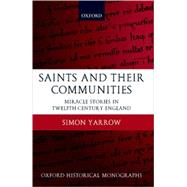Saints and Their Communities Miracle Stories in Twelfth-Century England
, by Yarrow, Simon- ISBN: 9780199283637 | 019928363X
- Cover: Hardcover
- Copyright: 4/27/2006
Saints and their Communities offers a new approach to the study of lay religion as evidenced in collections of miracle narratives in twelfth-century England. There are a number of problems associated with the interpretation of this hagiographical genre and an extended introduction discussesthese. The first issue is the tendency to read these narratives as transparent accounts of lay religion as if it were something susceptible to static, 'ethnographic' treatment in isolation from wider social and political activities. The second issue is the challenge of explaining the miraculous as acredible part of cultural experience, without appealing to reductionist notions of a 'medieval mindset'. The third issue is the problem of how to take full account of the fact that these sources are representations of lay experience by monastic authors. The author argues that miracle narratives werethe product of and helped to foster lay notions of Christian practice and identity centred on the spiritual patronage of certain enshrined saints. The six main chapters provide fully contextualized studies of selected miracle collections. Yarrow looks at when these collections were made, who wrote them, the kinds of audiences they are likely to have reached, and the messages they were intended to convey. He shows how these texts served torepresent specific cults in terms that articulated the values and interests of the institutions acting as custodians of the relics; and how alongside other programmes of textual production, these collections of stories can be linked to occasions of uncertainty or need in the life of theseinstitutions. A concluding chapter argues the case for miracle collections as evidence of the attempt by traditional monasteries to reach out to the relatively affluent peasantry, and to urban communities in society, and their rural hinterlands with offers of protection and opportunities for them toexpress their social status with reference to tomb-centred sanctity.







